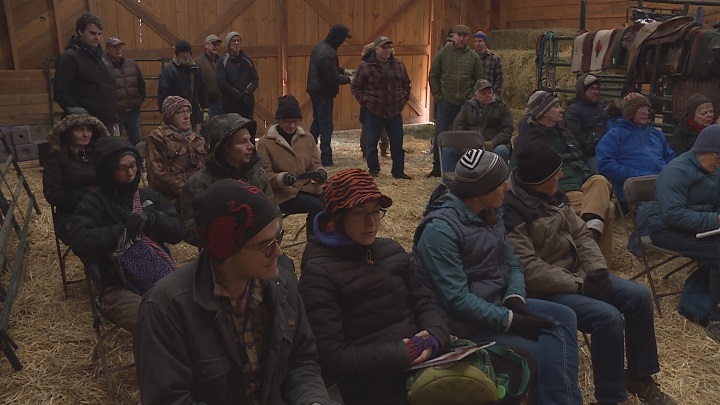Two dozen farmers from across the Thompson-Okanagan braved cold temperatures and gathered in a chilly barn in Okanagan Falls, B.C., on Wednesday to learn about wildlife management.

Agriculture is a major contributor to the Okanagan’s economy and includes a resilient mix of crops and livestock, but the valley is also home to many at-risk species.
Brian Thomas has been cattle ranching since 1957 and said bighorn sheep and deer pose the greatest threat to his forage crops.
https://twitter.com/Shelby_Thom/status/1062791906415992832
Instead of installing fencing, he has opted to enroll in the Agriculture Wildlife Program. The B.C. Ministry of Agriculture compensates him for lost forage due to wildlife.
“As you get more vineyards and orchards, just fencing out their orchards, it’s less and less place for these animals to go, so I would rather get compensation than put up a fence,” he said.

Get breaking National news
Paul Sime farms 75 acres of grapes in Monte Creek near Kamloops and raises Angus cows. He said predators often attempt to prey on his livestock.
“The worry is sometimes we get cougars coming down from the hills. We’ve got a lot of mountain sheep around, so they can be a vector for disease as well,” he said.
The aim of the “Managing for Wildlife on the Farm” workshop, hosted by the Okanagan Similkameen Conservation Alliance, was to provide farmers with tools to manage wildlife so they don’t take matters into their own hands.
“Farming is a tough gig. You don’t get your guaranteed pay cheques, you’re at the mercy of the elements. So I can see where the conflict comes from and why you’d want to take it into your own hands because you have to protect your crop,” said eco-studies coordinator Tanya Brouwers.
“But there are ways to work with the wildlife as well,” she said.
Brouwers said removing attractants will keep bears at bay.
“If you’re composting, keep it away from worker areas. If you’re a livestock farmer, keep carcasses away from those areas and be loud,” she said.
Brouwers also suggests using birds of prey to manage rodent populations.
“Working with wildlife, if you’ve got owls, raptors, they take care of a lot of the rodents so that you can minimize your use of poisons,” she said.
“I think farmers and the species at-risk can work together quite well.”






Comments